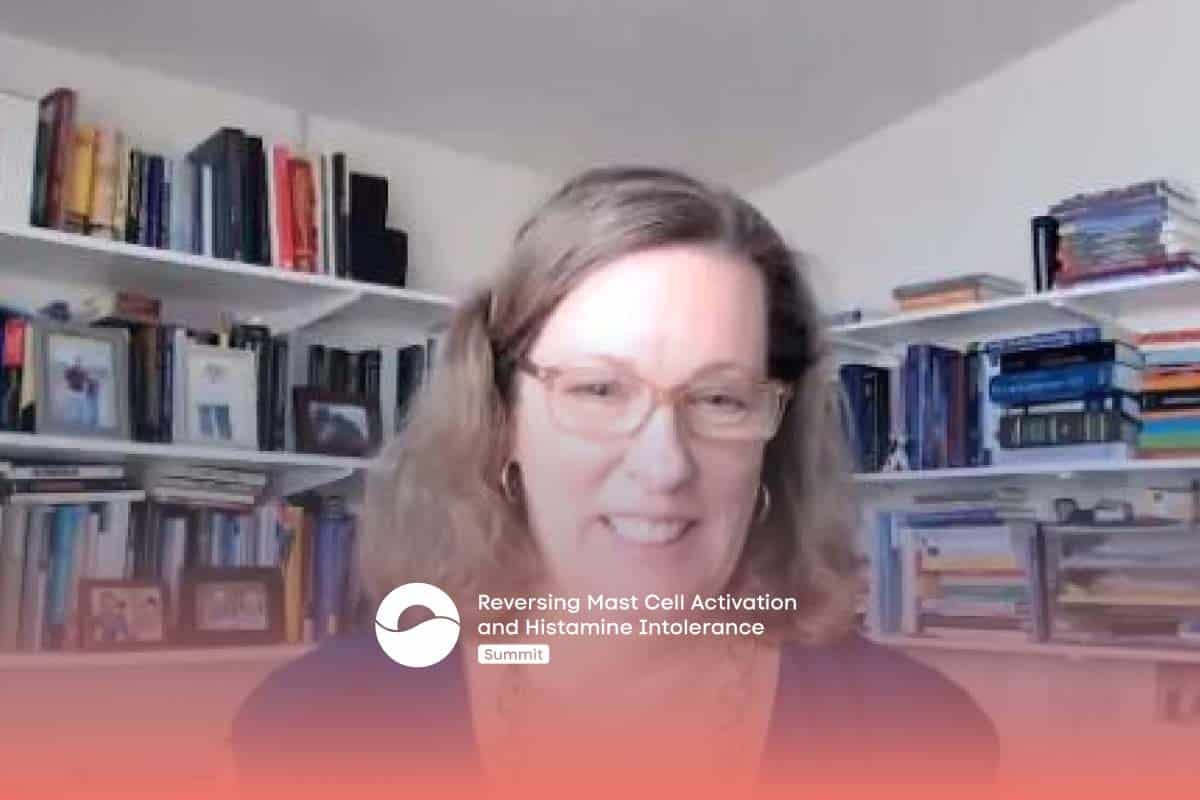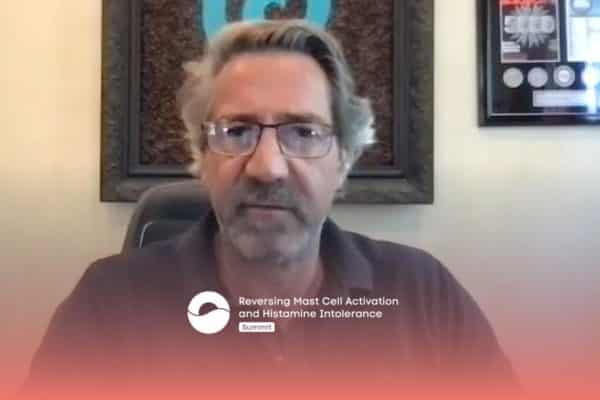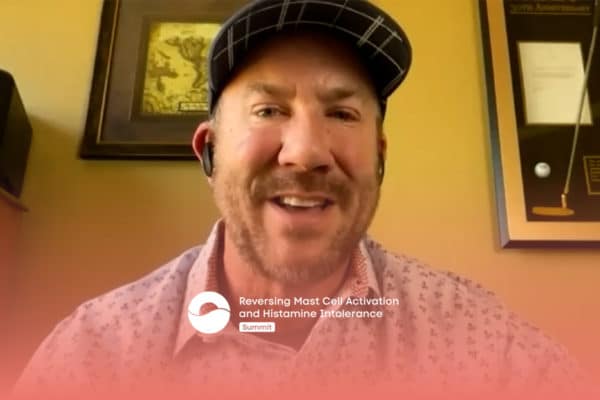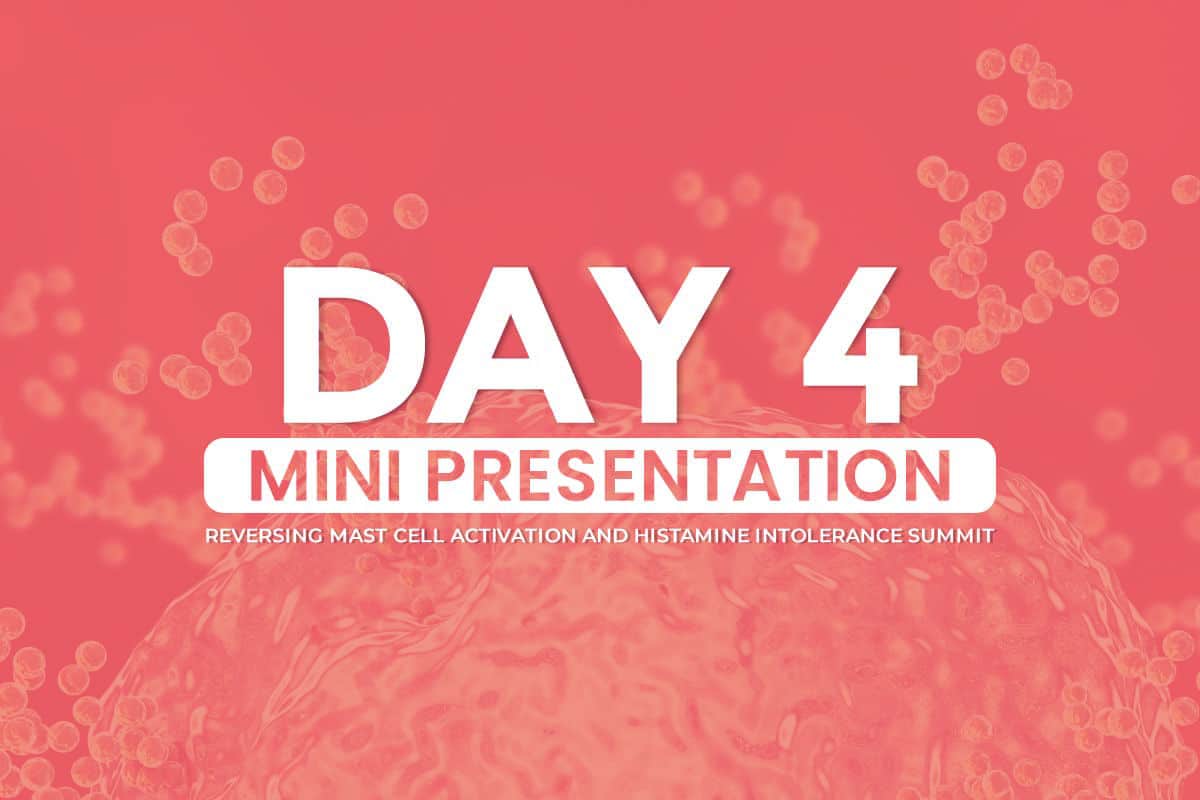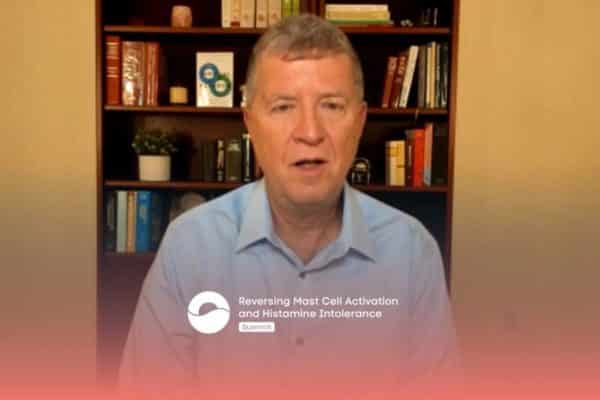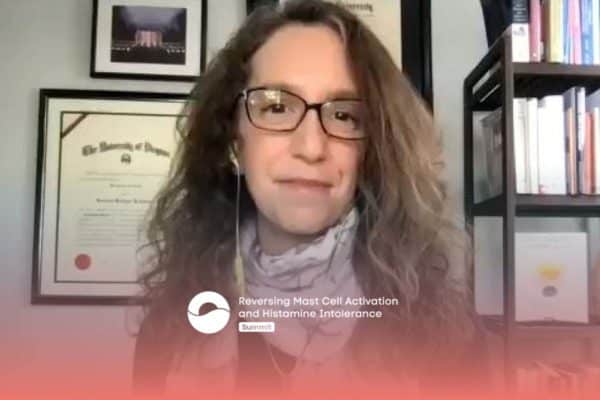Join the discussion below
- Why B1 is the most critical nutrient to start
- Roles of B1 in mitochondria, nervous system, energy, immune function
- How and when to onboard B1 for sensitive people
Related Topics
Brain, Brain Health, Cognitive, Energy, Fatigue, Mast Cell Activation, Mitochondria, NutritionBeth O’Hara, FN
Welcome back to the Reversing Mast Cell Activation and Histamine Intolerance Summit. I’m your host, Beth O’Hara, of Mast Cell 360. And today, we are going to have what I think is a game-changing conversation for people dealing with sensitivities, with mold toxicity, with mast cell activation, and issues like dysautonomia, chronic fatigue, brain fog, the list is gonna go on and on. But I really hope that you stay and listen to this entire interview because this is huge information, and it’s really new to some of the things that we’ve been talking about, even though it’s been around for a while. We’re gonna be talking with Dr. Chandler Marrs and she’s an independent health researcher and writer. She’s the co-author of the book, “Thiamine Deficiency Disease, Dysautonomia, and High Calorie Malnutrition,” is also the author of over 200 articles on various topics from women’s health and hormones, medications, reactions, mitochondrial function, and dysfunction. And she’s the founder and editor of the online health journal called “Hormones Matter.” That’s her website, I really encourage you to check it out. And there’s an archive of over 1,400 articles and an in-depth research analysis, and patient case stories. And she’s founder and administrator of a patient group on Facebook called Understanding Mitochondrial Nutrients. Her work has changed my work and I have a huge depth of gratitude for that, and it’s changing how we’re working with our really sensitive population here at Mast Cell 360. And just a fun note about her, in her spare time, she’s a competitive power lifter, and I’ve seen a couple of her videos on YouTube. It’s impressive, and she works to support strength sports for older women through her website and Facebook group called Old Ladies Lift. Welcome, Dr. Chandler. It is just a delight, a pleasure, and an honor to have you with us.
Chandler Marrs, PhD
Oh, thank you for having me. I appreciate it.
Beth O’Hara, FN
Can you tell us a little more about how you got into specializing? I mean, I just want people to understand the massive depth of specialization and research in thiamine. I’ve been gobbling down every piece of your work I can get my hands on. How did you get into this and make some of these discoveries? ‘Cause this is really game-changing.
Chandler Marrs, PhD
Well, I owe a huge debt of gratitude towards Dr. Derrick Lonsdale. This has been his life’s work for the last 40, 50 years. He’s 90-something at this point. And he and I met through a parent of a young woman who had been injured by the Gardasil vaccine. The mom had done her research and discovered that her daughter was thiamine deficient. And when someone looks up thiamine deficiency, the first person they see is Derrick Lonsdale. She had reached out to Dr. Lonsdale and the two of them had been communicating back and forth about healing her daughter. We had been communicating about other factors ’cause I had begun doing work on Gardasil injury and it had led me to the thyroid, and it had led me to some other hormone issues, which was my original background. The mom introduced us, and from that point forward, Dr. Lonsdale and I worked together to figure out what was going on with Gardasil injury.
That was kind of our first foray in working together. And he introduced me to thiamine deficiency. And I have to say, as I have a PhD, I have studied all sorts of things and brain chemistry, and everything else. And while I knew about thiamine deficiency, I knew about it only from the context of chronic alcoholism, Wernicke-Korsakoff syndrome, and so on. And I thought to myself, “Certainly, we don’t get thiamine deficient today,” you know? But Dr. Lonsdale schooled me in all of the ways that thiamine becomes depleted in modern living, vaccines being one of them, but all sorts of medications and the foods we eat, and everything else. And that, in fact, there are a lot of people walking around with, if not blatant deficiency, insufficiency to their needs. And gradually over the years, in the writing, the working together, we discovered how truly enormously important thiamine is to chronic health issues, and that almost all of them come back to a problem with not enough thiamine to meet the needs of that individual. And so, my work has now moved into that almost exclusively.
Beth O’Hara, FN
And for people that this is new for, I just wanna explain to them that thiamine is B1.
Chandler Marrs, PhD
Yes, it’s vitamin B1.
Beth O’Hara, FN
And I had also only been really aware of B1 deficiency in things like severe alcoholism, anorexia. And then we do work with a lot of people with significant nutrient deficiencies because they’ve been down to two foods for quite a while. But I had not had the focus on B1. And when I found your book, Dr. Neil Nathan actually mentioned it and said, “You’ve gotta read this.” And if he tells me to read something, I read it. And I got your book and I just immediately was like, “Why haven’t I seen this before? Why am I just now hearing about it?” That was a year ago. What’s happened here? Because one, I think… a couple questions. Why aren’t we talking about it enough? And the difference between the classical, how it’s defined as beriberi, and what you’re talking about. And then also, and we have to speak about the RDA and… I have that conversation a lot, and I know you probably have that conversation a lot. And people say, “Well, I’m getting 200% of the RDA.” And it’s like, “Okay, good.” If it’s-
Chandler Marrs, PhD
You’re getting two milligrams then, because the RDA is one milligram of thiamine, 1.1 and 1.2.
Beth O’Hara, FN
Well, we look at vitamin C-
Chandler Marrs, PhD
If you’re pregnant, 1.4.
Beth O’Hara, FN
When we look at vitamin C, I’m like, “Okay, good, you’ve met the RDA so your teeth are not gonna fall out, but that doesn’t mean you’re functioning optimally.”
Chandler Marrs, PhD
Exactly. Well, let’s back up even a little bit more. Let’s talk about what thiamine does so we can understand-
Beth O’Hara, FN
Okay, good.
Chandler Marrs, PhD
from that perspective why it’s important. Thiamine, it’s a vitamin, like you said, it’s vitamin B1. But it’s critically important in our ability to convert food into energy. So whenever we eat, we get a bit of macronutrient, which is your protein, your carbs, and your fats. And we get, in theory, vitamins, micronutrients, thiamine being one of them. But, you know, all foods have different vitamins and mineral composition. If you eat a decent diet, then you should have sufficient quantities of both. But most of us don’t eat a sufficient diet, first off. So, thiamine, unlike all of the other vitamins and minerals, well, thiamine and it’s partner, magnesium, sits atop at the entry point to that processing of those macronutrients into ATP, which is energy, okay? Now, all of our cells need ATP to do whatever it is they do, and they need a lot of it every day. And so, we need to eat sufficient amount of food with sufficient of the substrates, which are the macronutrients, and sufficient vitamins to power the enzymes inside and around the mitochondria to kick out that ATP. If we do not have sufficient micronutrients, thiamine being the key, again, then no matter how much food we eat, you know, mostly empty calories but even the other substrates, no matter how much we eat, if we don’t have enough thiamine, it’s not gonna come out to the other side and be energy.
It’s gonna be diverted into different pathways so that your body can kind of pull whatever it can out of it, and it’ll store some of it. That’s why a lot of us become overweight. But it won’t get into the mitochondria to produce energy. So if we don’t have enough thiamine, we don’t have have enough energy for the cells in our body to keep us alive in a very functional way. And so if you think of chronic fatigue, what is the key symptom there? Fatigue, it’s a lack of energy. And it’s not a lack of calories, it may be at some point because once you get to a certain point where you have such low and poor nutrient content, you can’t eat anymore. One of the first symptoms that you get is difficulty actually eating because you just don’t have the energy to eat and to derive those micronutrients out of the food and to power everything else. So, thiamine is critically important for creating energy. And everything we do, every breath we take, everything in our bodies, every heartbeat, everything is energy. And if you don’t have enough, things are gonna go wrong. So, that’s the first thing. So then the second question is how in this world where starvation is not necessarily a component, at least not in-
Beth O’Hara, FN
In modern world, in our world.
Chandler Marrs, PhD
in a modern world, yes, in other places, it is. And how, absent alcoholism, do we get individuals with low thiamine? Well, that, again, is the way we structure our diets here, or a large component. So, we grow foods using a lot of intense chemicals. We strip the soils of minerals. We grow the foods so that they are bigger fatter, prettier, which ultimately means higher sugar content, and then we process the heck out of everything, adding all sorts of other chemicals. And then at the end, we come back and we add a few vitamins and minerals to them so that they have some nutrient content. And so there’s this kind of corrupted nutritional landscape in which we have all kind of survived on for the last two generations, at least. And so even though a lot of these foods have vitamins and minerals in them, they have been added back after being stripped. So they don’t come in the original form and they come with a variety of other toxins that are associated with that food, and just an enormous amount of calories in most cases ’cause high sugar is sugar and hydrogenated fats. So, that’s one way, high calories.
The more calories, the more sugary foods, more carbohydrate-y, empty calorie foods you eat, the more thiamine you need to process it. Okay, so that’s one way. The other way is all the other things we do. You know, we drink coffee, tea, we do drink alcohol on a regular basis, even if one is not a chronic alcoholic per se, regular alcohol depletes it, tea, coffee does, soda pop does, almost all of the medications that we take with great regularity either damage the mitochondria such that they need more thiamine, more energy to heal, or they directly deplete the thiamine. Environmental toxicants. I mean, there’s just a long list of modern exposures that deplete thiamine, none of which are considered when we think of the classical definitions of thiamine deficiency, which, typically, if you look up on the internet and you see pictures, you see people who are starving or alcoholics, those are the two key ones. And we have a lot of people that are just walking sick because of dietary exposure, life stress, everything that requires energy requires thiamine.
Beth O’Hara, FN
I just wanna highlight some really critical things that you said, and then recap a little bit for our audience.
Chandler Marrs, PhD
Sure.
Beth O’Hara, FN
So, one, what we’re talking about is that we are living in this world that stresses us tremendously, and we don’t have the nutrient density that we used to have.
Chandler Marrs, PhD
Correct.
Beth O’Hara, FN
I’ve also found studies going back to 2015 on how mycotoxins greatly deplete B1, and that’s a big factor for a lot of people in our audience. One of the other things… and most of them, they’re not drinking soda pop, they’re eating pretty clean, but that-
Chandler Marrs, PhD
At this point, but were they eating clean before they became ill?
Beth O’Hara, FN
Good point, and I used to, in college, before I understood these things, start my day with a Coca-Cola and-
Chandler Marrs, PhD
Diet Coke, me too.
Beth O’Hara, FN
And packaged peanut butter crackers out of the vending machine.
Chandler Marrs, PhD
There you go.
Beth O’Hara, FN
So, I didn’t have good nutrition until right after I had graduated. And tea, I know we’re talking about the traditional tea, the black tea, the green tea, some people are gonna have a question, “What about herbal teas?” But we’re talking about the tannins in those teas.
Chandler Marrs, PhD
Yes.
Beth O’Hara, FN
So, what we’re talking about also, I just wanna add into this conversation for people that many in our community have tried B6, B12, folate, and what’s been wonderful for me is to see the order of operations and bringing these nutrients on board. And that there’s a prioritization in terms of what has to come in first. So a lot of people group and say, “Oh, I can’t take any B vitamins.” And I just wanna say, I don’t see that, you don’t see that, it’s really… we have to do them in the right order, which I know we’re gonna touch on here.
Chandler Marrs, PhD
Right order, right quantity or concentration. You can’t go all out out of the gate.
Beth O’Hara, FN
Mm-hmm.
Chandler Marrs, PhD
And I think that’s a problem that most folks suffer with because they’ve been so ill for so long, they want something to help and they take too much too soon.
Beth O’Hara, FN
So one of my burning questions is why… you know, I’m on top of anything in this population, I study so much, I read, I’m training constantly, I’m drinking from a fire hose every day. And that question I kept having as I was reading the book and reading your work was, why have I not heard of this before now? What’s happening with that? And because I know if people go and they start this conversation with even their functional medicine docs… I mean, I have a thousand page textbook that’s a recent publication on integrative and functional nutrition, and there’s four paragraphs on thiamine.
Chandler Marrs, PhD
Really? Oh, that’s bad.
Beth O’Hara, FN
Page textbook.
Chandler Marrs, PhD
I think the primary reason we’re not hearing about it is because we believe we solved it with food fortification. And so, but as we discussed previously, the problems with food fortification is it comes with a heck of a lot more than just the few vitamins that they add back at the end. But that’s the primary reason, that and I think it was entrenched into the general institutional dogma that the only culprits of this would be chronic alcoholism and starvation. Now, you’ll see it in medical journals, too, this notion that it’s rare. So, almost every case study you read of thiamine deficiency, rare case of this… you know, of Wernicke’s encephalopathy with X, or a rare case, rare is always used in this context. And I think so that kind of feedback loop of the rareness of this continues, and so we just don’t look for it. But once you start looking for it, the floodgates just open wide and you’ll find that reasonably and logically, there are so many conditions that can cause thiamine deficiency. First, you’ve got the diet and we discussed that, but any virus, it’s gonna require more energy to… just from a fundamental standpoint, more energy to resolve any illness, any surgery. If a woman is pregnant, she requires more, if a woman is pregnant and is vomiting constantly, hyperemesis is one of the key indicators, not only of thiamine deficiency as a cause, but thiamine deficiency, definitely, as a consequence.
Beth O’Hara, FN
And not just in pregnancy but…
Chandler Marrs, PhD
Yes, if you’re vomiting-
Beth O’Hara, FN
reciprocal vomiting.
Chandler Marrs, PhD
Yeah, if there’s an illness that you have that causes you to vomit, but oftentimes, that vomiting, virus or bacterial infection aside, is an indication that there is not sufficient thiamine there to feed the bacteria and everything else all along your gut. So they actually produce a fair amount of thiamine and then absorb it into various transporters. And when you have dysbiosis of any means, they’re not going to be able to produce sufficient quantities. And as in anything, the strongest bacteria, which tend to be the more pathogenic bacteria or microbes, ’cause it’s not just bacteria, are the ones that can salvage thiamine from various pathways, and they’re the ones that kind of starve everything off. So, as your thiamine levels kind of decline systemically, but definitely within the GI tract, you get the more pathogenic microbes that come online, the good ones… or the bad ones, rather, that come online because they’re more adept at making thiamine from different substrates that the more benign and healthy microbes cannot do.
And so, all of these things impact whether or not you have sufficient nutrition or sufficient thiamine. And as those factors kind of start skewing, again, energy becomes depleted and maybe it becomes depleted in your gut first. And then it becomes depleted… maybe you have a genetic propensity for an issue with your heart and it becomes depleted there, or it goes into the brain, or you feel the muscles, it depends on the level of depletion and it depends on kind of your genetic makeup as to which direction it’s gonna go. But since the cells all need it, eventually it’s gonna affect everything.
Beth O’Hara, FN
So, I find it really interesting because our main audience here is mast cell activation syndrome, until very recently, that was thought to be quite rare, and mast cell issues were thought to be- Now, we’re looking at the epidemiological population. Studies are showing that we’re dealing with between 9 and 17% of the general population, the general population, not even talking about the chronically ill, who are dealing with mast cell issues. How common is thiamine deficiency as you’re describing it? And then let’s talk about the different presentations and symptoms so people can know whether to start considering this for themselves.
Chandler Marrs, PhD
Okay, so, depending upon the study population that is tested, thiamine deficiency can range anywhere in any given population between 10 and upwards of 90%. So, you see… you know, they did a random study in the UK of just anybody who walked into the emergency room, you know, broken arm, whatever, it could be anything, and it was 20%. Diabetics are typically… Type 1 and Type 2 diabetics, typically have a higher incidence of it because they excrete it more frequently. And so it can be upwards of like 70% there in diabetic populations. And when you think about it, thiamine is the entry to how we metabolize glucose, being one of the major sources of fuel. And so if you don’t have enough thiamine, you cannot metabolize glucose into energy. And so what happens to that glucose? It kind of floats around and you end up with insulin problems and everything else. So, the ranges are quite high depending upon the population tested, but we don’t test very frequently is the problem. So even you talk to patients today who want to get a thiamine test, who have clear symptoms of thiamine, neurological symptoms of thiamine deficiency, and the doctors won’t order it.
Beth O’Hara, FN
So now we have to talk about the testing problems.
Chandler Marrs, PhD
Yes, so there’s a lot of problems with testing. And so, those are some technical questions to answer, but the difficulty with most blood testing is it’s very sensitive to what you’ve eaten recently and what your current exposure to thiamine is. So if you are supplementing a multivitamin, or if you are eating a lot of highly fortified foods, it may show… you’re gonna get a false negative. It’s gonna show that have sufficient quantities of thiamine, when in reality, that’s just because you’ve been exposed to it and it’s not necessarily what’s working in your body and what’s being-
Beth O’Hara, FN
What we see the blood is not what’s happening in the mitochondria itself.
Chandler Marrs, PhD
In the cell, yeah. And so, some of the tests that we would like to have run are only available at two labs, one in the US and one in the UK.
Beth O’Hara, FN
I was gonna say, I’ve only found one lab that’ll run the ETKATPP-
Chandler Marrs, PhD
Yeah.
Beth O’Hara, FN
here in the United States.
Chandler Marrs, PhD
Yeah.
Beth O’Hara, FN
And it’s not available to consumers.
Chandler Marrs, PhD
It’s not, yes. So it’s virtually impossible unless you are severely and frankly deficient. And there are, again, there are patients walking around who by current testing methods are severely and frankly deficient.
Beth O’Hara, FN
Yeah.
Chandler Marrs, PhD
And yet, they’re walking around. They may not be emaciated, they may not be an alcoholic, they likely have a lot of unexplained health issues, but no one has paid attention to the thiamine and they haven’t gotten the thiamine test. And/or there are patients whose doctors have ordered thiamine tests who show frank deficiency and no one does anything about it.
Beth O’Hara, FN
Well, in my own case, I’ve seen hundreds of B1 tests. I didn’t know the testing issues.
Chandler Marrs, PhD
Yes.
Beth O’Hara, FN
And I didn’t know the… I know the Krebs cycle, I know the co-factors, but I didn’t know the extent of how this deficiency can affect these kinds of symptoms. And I think this is where this is such an important conversation.
Chandler Marrs, PhD
Well, I think it’s also in terms of how we define deficiency. So if we look at lab values, the lab values for thiamine are like from six or seven, all the way up to, like, I think it’s 180 nanomoles per liter, or I can’t even remember the unit, but it’s enormous range. So if someone tests nine, and the cutoff’s seven, you know, are they deficient? Technically no. Do they have enough to make their living, you know, to perform the task of daily living in a functional, healthy way? Probably not. Similarly, if they have 100 or 150, does that mean that that is sufficient? Well, under technical terms, it does, but what if that individual is regularly exposed to things that prevent the absorption of thiamine or break it down? Or if they have genetic components that affect how thiamine is transported and no one’s paid attention to those? So even though their levels appear to be within a range, they’re still critically or chronically ill. And so, it’s not deficiency in the sense that you are either deficient or you’re not, it’s how much does your body need for it to function well?
Beth O’Hara, FN
Yes.
Chandler Marrs, PhD
And that’s the question we don’t ask enough.
Beth O’Hara, FN
That functional view.
Chandler Marrs, PhD
Yeah.
Beth O’Hara, FN
Even aside from the B1 blood testing, having massive problems.
Chandler Marrs, PhD
Yes.
Beth O’Hara, FN
And so…
Chandler Marrs, PhD
Yes.
Beth O’Hara, FN
So if people develop deficiencies, and this is what I want our audience or our community members, if they haven’t followed everything we’re talking about, to really hear this part, how does this show up for people? Particularly, we see so much dysautonomia, sensitivities, chronic fatigue, brain fog, and you mentioned weight gain and really, we’re gonna hit on-
Chandler Marrs, PhD
Or weight loss.
Beth O’Hara, FN
Or weight loss, which are both a problem in this community. And then I know there’s a lot more you can add around that.
Chandler Marrs, PhD
Well, so let’s back up just a little bit. So, remember we talked about thiamine being critical for the production of energy in the mitochondria? Okay, now the mitochondria are basically your batteries, your cells’ batteries, and they are in every cell of your body. And so if you don’t have enough thiamine and if you don’t have enough energy, the battery runs low, okay? Now, that battery running low could happen depending upon your environment and your genetic makeup, can happen in any part of your body. So, the initial symptoms could be completely random, you know? You could start having little twitches or some eye issues. You could start having a little bit of muscle weakness. You could start having… GI symptoms are usually quite significant once the deficiency has gone on for a little bit of time, you know? But it could start out as things that you don’t quite look at as being a vitamin deficiency, you know? And so it may take months to build, because think about how you consume your vitamins and minerals. They’re gonna wax and wane relative to what you eat and relative to the stressors you experience. So, while you may get a period where you’re really low, life may intervene and you may get a period where you’re sufficient, and then you flip back and forth until at one point, there’s this like final straw and everything just goes to crap. And it’s like now-
Beth O’Hara, FN
We can all relate to.
Chandler Marrs, PhD
Yeah, there is. And so, whenever I talked to people, there’s this assumption that they were healthy until, you know? I was healthy until. And then when we dig in, it’s like, were you really healthy? Or were you just functioning better, you know? And it’s often, no, they were just functioning, they were making do, they were compensating ’cause our bodies are remarkable. They’re gonna keep us alive no matter what we throw at them. And so, we often find that there were probably extended periods of nutrient deficiency across their lifetime, but they managed to survive them because life is like that. It’s up and down and up and down. And so, the symptoms in modern thiamine deficiency are symptoms of mitochondrial dysfunction. So if you look up any symptom of mitochondrial dysfunction, you find that every symptom under the sun can be considered mitochondrial dysfunction because of the way the mitochondria fuel every cell in the body.
So, the seemingly huge diversity of symptoms, if you see a whole bunch of unexplained symptoms and it can’t simply represent this person has seven different disease processes going on, you know, all with 15 different symptoms. You gotta think mitochondria and then you gotta think thiamine and other nutrient deficiencies. So that’s kind of the key. You gotta get away from those late stage classical signs, which are the neuropathies in the legs, the cardiovascular dysfunction, and the array of neurological symptoms, you know, the brain fog, the memory issues, the speech issues, the nystagmus in the eyes. If you’ve gotten to that point, it’s been going on a long time and/or you had a severe, severe abrupt illness that tanked you immediately. But either way, this is the later stage. You’ve gotta start looking at the earlier stages of this process when things are just not quite right, and you don’t feel quite well, and you’ve got a lot of weird, little things going on. That means you’ve got some nutrient deficiencies.
Beth O’Hara, FN
Yes, and I think from reading your work, the symptoms that are really common in these populations are gonna be the chronic fatigue, the brain fog. We do see a lot of neuropathies and then as people have been getting started on the B1, they’ve been working on it for years and they come back and they say, “Oh my gosh, you know, that was the missing key.” So that’s been exciting. It’s, of course, not a magic bullet but-
Chandler Marrs, PhD
Certainly. But it’s an important bullet.
Beth O’Hara, FN
Yeah. And then weight gain or weight loss. I don’t get a lot of people that are at their ideal weight. They either have too much weight or they can’t keep weight on, the vomiting. I have had horizontal nystagmus for years and I thought it was from a head injury. And I just realized reading your work, holy moly! I have not addressed this part.
Chandler Marrs, PhD
Well, that’s interesting. So, and that is one of the cardinal symptoms of thiamine deficiency is nystagmus. Ataxia is the other one.
Beth O’Hara, FN
And for our lay people, I just wanna say that nystagmus is where the eyes dart back and forth-
Chandler Marrs, PhD
The eyes move. They bounce funny. And you can go online on YouTube and look at videos of nystagmus. And then you can have a friend or a partner test, you can even probably see it in the mirror yourself. But if you have some-
Beth O’Hara, FN
I don’t know when it’s happening but my husband does, and I’m compensating.
Chandler Marrs, PhD
Yeah. There you go, so have a partner, go look up the videos online and then have a partner, and then look up ataxia online, and, you know, drunken sailor walk, different disturbed gait.
Beth O’Hara, FN
I’ve had that for years. I can’t walk a straight line.
Chandler Marrs, PhD
Exactly.
Beth O’Hara, FN
I’m terrified of getting pulled over.
Chandler Marrs, PhD
And those are those key symptoms and that everyone is trained in. That’s why I don’t understand why people don’t see these.
Beth O’Hara, FN
Well, I don’t think anybody-
Chandler Marrs, PhD
It’s so easy to identify.
Beth O’Hara, FN
I don’t think it’s ever happened when I was in a provider’s office.
Chandler Marrs, PhD
Oh. But if you walked heel-toe though, would you…
Beth O’Hara, FN
Can I walk heel-toe?
Chandler Marrs, PhD
Yeah, when you were low with thiamine, could you walk heel-toe?
Beth O’Hara, FN
I don’t know. I’ve had so many injuries. So, it’s complicated.
Chandler Marrs, PhD
Okay.
Beth O’Hara, FN
But definitely those are some pieces people can look at. What are some other… I’ve really been looking at it in terms of the level of sensitivities people get and the role in nervous system firing and functioning.
Chandler Marrs, PhD
Yeah.
Beth O’Hara, FN
In terms of, we work a lot on limbic, we work a lot on vagal in terms of improving the signaling, but now I’m at this level of, okay, well, but what if we can’t get it to fire?
Chandler Marrs, PhD
Exactly. So you have to take it a step down and say, “What does it require to fire?”
Beth O’Hara, FN
Yeah.
Chandler Marrs, PhD
And the most basic requirement is that it has sufficient energy.
Beth O’Hara, FN
Yeah.
Chandler Marrs, PhD
And if it doesn’t, then it doesn’t matter what else you do. You’re not gonna fully resolve the issue. That doesn’t mean that other treatments and therapeutics might not be needed, or other vitamins and minerals and other things, but you have to solve the energy deficit problem. And to do that, it absolutely requires thiamine. And it absolutely requires magnesium, too. Magnesium activates the thiamine. So if you are magnesium deficient, you can be functionally thiamine deficient because there’s not enough to activate the thiamine.
Beth O’Hara, FN
And just explain to people, that’s working… I don’t know if we can technically call it a co-factor, is it working as a co-factor?
Chandler Marrs, PhD
It’s a co-factor, yeah-
Beth O’Hara, FN
So, it’s dependent on the magnesium. And then this, again, that order of operations, we have to bring things on in terms of their dependence.
Chandler Marrs, PhD
Yes. And there’s a big push in a lot of natural health circles to do huge doses of magnesium right out of the gate. And I personally think this is problematic because if you look at the way magnesium works in the mitochondria, if you break it down to some of the technical things, it actually will cause a feedback loop to prevent the certain enzymes from working, which shuts down the ability to produce the energy. And so, I am not a proponent of starting magnesium first. I’m a proponent of starting thiamine first with magnesium if you could tolerate, not everybody can tolerate magnesium out of the gate. We found that sometimes they need magnesium and calcium. They often will need potassium, not necessarily in a supplement, that they have to do it in a food, unless they’re down to a few foods, then they’re gonna have to do an electrolyte drink to get that. But because… If you wanna talk about order of operations, because thiamine sits at the entry points, I believe thiamine is something that you have to start to begin with. If you start with magnesium or if you start with B12, which is a different pathway, or B9, or if you start with some of the-
Beth O’Hara, FN
Which is folate.
Chandler Marrs, PhD
Yeah. Those are vitamins that use energy more than produce energy.
Beth O’Hara, FN
So then we can get into more of a deficit of the B1.
Chandler Marrs, PhD
Yes.
Beth O’Hara, FN
Which I think we see so much in this population is really helpful for people to hear because they get put on methylfolate, they get put on different forms of B12. They can’t tolerate it, they can’t tolerate B6. Sometimes they can tolerate B2.
Chandler Marrs, PhD
Because B2 sits in the same enzyme as thiamine does. And so, it’s kind of kicking that pyruvate enzyme up a little notch.
Beth O’Hara, FN
And the Krebs cycle to transit-
Chandler Marrs, PhD
Yeah, to get everything going. So it’s at the top. Well, but same enzyme, also at the top with thiamine, is alpha-lipoic acid. That’s another one that people will take these high doses in and then they’ll end themselves in thiamine deficiency again. And so you have to feed the mitochondria stuff that’s gonna make them produce energy, rather than stuff that’s going to utilize energy.
Beth O’Hara, FN
Yes, that makes so much sense. Now, I know people are gonna wanna try starting this themselves. This is not the simplest thing to navigate.
Chandler Marrs, PhD
No, it is not.
Beth O’Hara, FN
You’ve been invaluable in the exchanges we’ve been having around how to navigate with sensitive people. But I wanna give people some practical tips and then encourage them if you’re having trouble. You know, I know you do some consulting. We do consulting work with somebody who gets this so that you’re not stuck in it if you’re having trouble but…
Chandler Marrs, PhD
Well, technically, I don’t do patient consulting, but yes, I do. It’s complicated.
Beth O’Hara, FN
I know you do research consulting.
Chandler Marrs, PhD
I do research consulting-
Beth O’Hara, FN
Yeah, you do research consulting.
Chandler Marrs, PhD
But I would encourage people firstly, I know, I’ll go into some of the things they need to consider, but I would encourage them to read our website, read the articles on thiamine on our website, on hormonesmatter.com. Read the case stories particularly because you will see yourself in some of them, I guarantee it. And you will see how the individual patients had to approach it, and everybody’s a little bit different. I think that’s important to understand. There is not… I know there are people who put out protocols and everybody wants a protocol, but I am fundamentally against protocols.
Beth O’Hara, FN
We can’t do that.
Chandler Marrs, PhD
Yeah.
Beth O’Hara, FN
But we have a method. And so, this is in the very early phases-
Chandler Marrs, PhD
There’s a framework.
Beth O’Hara, FN
There’s this very early stages of our framework now is the thiamine, bringing it on board.
Chandler Marrs, PhD
So, let’s go back. So, in supplementing thiamine, you have people who will do quite well on it early on, and those are the easy ones. They take those-
Beth O’Hara, FN
We don’t have many of those on here.
Chandler Marrs, PhD
Yeah, and they’re fine and they feel great. They get an instant burst of energy and everything’s wonderful. And it’s a semi-linear trajectory to recovery. Most people are not like that. Most people will have some sort of reaction to the extra energy. So again, let’s go back to the mitochondria and the chemistry, perhaps in a simple way. You have mitochondria, and then the cells in which they reside have been operating on low energy for an extended period of time. And so, in order to keep you alive, they have kind of changed their systems and their operating systems. They’ve up-regulated some things, down-regulated other things, you know? Just kind of mixed it all up to keep you alive.
Beth O’Hara, FN
And they’ve got these different byproducts happening.
Chandler Marrs, PhD
Yeah, got different byproduct, got all sorts of things that are going on. Now, all of a sudden, you’re gonna give it a jumpstart, or give them a jumpstart, and it doesn’t go smoothly. It’s like when you’re jumpstarting an old car, you know? It kinda sputters and shoots things out. On a molecular level, all of those things that were rewound one way, now have to be rewound another way in the presence of that energy. And there are awful lot of hiccups and those hiccups can make all of your symptoms worse and present with a whole bunch of new ones. And so, there are a couple ways to navigate it. If you are fortunate enough to work with a physician who can give you IV and do high dose, and monitor you and give you all of the electrolytes, then go that way. If you are not, which most people are not, you’re gonna have to start out at a low dose and gradually, sometimes extremely slowly and extremely low doses, titrate up over an extended period of time.
Beth O’Hara, FN
And slowly means, like, are we talking about sprinkles? Little crumbs.
Chandler Marrs, PhD
Yeah, you may get a milligram of thiamine in and you may have to sit at that level for weeks until everything settles down. And then you can go up to maybe a little bit more and then a little more, so it’s a stair step. You pick your dose and then you hold, and then you pick a little bit more and you hold, and so on and so forth. And you do that until you’re up to a dose where things start improving.
Beth O’Hara, FN
And one of the things you helped me with is often in this audience, in this community, we’ll have people do a little sprinkle, wait two or three days, and then do another little sprinkle. But in the B1, it’s better to stay-
Chandler Marrs, PhD
Stay.
Beth O’Hara, FN
continual. And don’t stop and start and stop and start. And also, we can take the dose down if we need to make it more comfortable, but to find some way through.
Chandler Marrs, PhD
Yes.
Beth O’Hara, FN
And most things, if we start to have trouble with it, we come off of it in this population. But with the B1-
Chandler Marrs, PhD
It’s not the case.
Beth O’Hara, FN
we’ll find some way, even if we’re so sensitive, we put a sprinkle, like a few granules in water, and we sip that water all day long, that might be where we start.
Chandler Marrs, PhD
It might be, yeah. And that’s the difficulty with this. And you pick what you can handle and you hold at it. Now, you also have to do that with magnesium. Or if your diet allows, up your magnesium content and your potassium content, and your other things in diet. People drink coconut water, coconut milk, coconut cream, you can do things like that and that has a lot of the electrolytes in it, and that helps. And plus, if you get the cream, it’s fatty acids, which are perfect for you. So you can do things like that. You can up your diet in the various electrolytes, and just go online and look up, and find foods that you like that have higher concentrations of magnesium, potassium. You’ll probably need more salt, phosphorus, so, phosphate to protein, and things like that. You can use the application chronometer to enter the foods that you’re taking, and it gives a pretty good micronutrient breakdown. And you can see what’s going on there and you’d be shocked. Personally, when I do it, because I don’t eat any processed foods or fortified, I don’t eat breads or anything like that, I don’t ever get folate in my diet. So, I have to… Yeah. So you’ll find things where you don’t get enough of X or Y and you have to work at it to get it.
Beth O’Hara, FN
And this is where it can be helpful to have a guide to help you navigate what to bring on. Let’s talk about and wrap up with the three forms of thiamine ’cause most people are gonna go out-
Chandler Marrs, PhD
It’s actually four, but yeah.
Beth O’Hara, FN
Okay, the-
Chandler Marrs, PhD
Three that we like.
Beth O’Hara, FN
Let’s do all four. But most people are gonna go out and grab that thiamine HCL, or they often tell me, “Well, I’ve got thiamine in my multivitamin,” for the ones I see that can take a multi. And I’m like, “But that’s the thiamine HCL.”
Chandler Marrs, PhD
Yeah, so the couple forms, so the cheapest or the least expensive form is thiamine mononitrate. And that’s the one we tend to avoid because there’s a whole number of reasons, but that, you’ll see, in a lot of the less expensive multivitamins and over the counter, but don’t get that one. The second one is thiamine hydrochloride. And that one is a really good option. And that’s typically where most people have to start, but it’s not absorbed well, and it can be degraded easily. But it’s milder because it’s not absorbed well and it can be degraded easily.
Beth O’Hara, FN
It’s the form for sensitive people to start with.
Chandler Marrs, PhD
Yeah, it is a form for sensitive people to start with. So, I would consider that one. As you get more along or if you’re not as sensitive, there are two more potent options that I like much better, benfotiamine and thiamine… Well, brand names are Allithiamine, Lipothiamine, and Thiamax, It has a form called TTFD, don’t need to know what that stands for.
Beth O’Hara, FN
We just call it TTFD.
Chandler Marrs, PhD
TTFDM, those forms don’t require transporters. So if you have gut issues and/or you have genetic problems with transporters, they cross the cell membrane without a transporter. And, you know, they work better. They’re just more potent-
Beth O’Hara, FN
And they cross the blood-brain barrier better, right?
Chandler Marrs, PhD
Yes, and they do the blood-brain barrier better. Because they are more potent, they are difficult for some people to begin with. And they typically have to start with a thiamine HCL and titrate that up. Now, if you can only deal with thiamine HCL, and depending upon your health issues, you may need a very high dose of thiamine HCL because of, again, the absorption issues. When they-
Beth O’Hara, FN
What kind of is that? High dose or-
Chandler Marrs, PhD
Well, most people with chronic fatigue will need a 1,500 to 2,000 milligrams of HCL. Now, that does not translate to 1,500 to 2,000 milligrams of TTFD or benfotiamine. So you need a fraction of that. They’re not equal, but I mean, you may only need like 300 milligrams or 1,500 to 300 milligrams of the TTFD or the benfotiamine.
Beth O’Hara, FN
150 to 300 of the benfo, or the TTFD versus 1,500, 2,000 of the thiamine HCL.
Chandler Marrs, PhD
To the 2,000 of the HCL.
Beth O’Hara, FN
Okay, got it.
Chandler Marrs, PhD
But again, if you’re highly sensitive and chronically ill, which your population is, you may only be able to begin with like a milligram of thiamine HCL. And it may take you a long time to even get to 100. But if you don’t react to it, if you start out at a low dose of HCL and you don’t react to it negatively, then you could go up a little bit. So you have to really pay attention to how your body responds to it in order to find your dose. And I recommend people track. Start a spreadsheet, write down your symptoms, rate them 1 to 10, you know? And do this at least daily, if not multiple times a day, relative to the nutrients that you are adding so that you can determine what’s causing what and where there are improvements, ’cause oftentimes, there’ll be improvements in areas that are not your primary symptoms, but they’re still nagging symptoms. And that’s where it’ll start. And if you’re not tracking, you don’t notice.
Beth O’Hara, FN
That’s a great point. And one other piece I wanna just put out there for people is we’ve been doing a, start with the thiamine HCL, go to the benfotiamine, and then people tolerated the TTFD, but the place I found where we can’t do the TTFD is in hydrogen sulfide SIBO. And if we have that-
Chandler Marrs, PhD
Okay.
Beth O’Hara, FN
people may have to stay with the benfo. Some people, that TTFD is just too strong at that stage. So it may take six months to two or three years even to build all of this up, depending on how slow-
Chandler Marrs, PhD
In many cases it does, depending on the time that you’ve been ill and the severity of your illness, it may take quite some time. And that’s another thing, particularly if there are a lot of neuropathies involved, nerves regrow very slowly. And so, it’s not gonna happen in a couple weeks, but that’s why you’ve gotta track everything to see what’s going, but all of those systems have to rewind and that just takes time.
Beth O’Hara, FN
It takes time and patience is the key for everything-
Chandler Marrs, PhD
A lot of patience, yes.
Beth O’Hara, FN
in this population.
Chandler Marrs, PhD
It’s difficult.
Beth O’Hara, FN
I want to really thank you for your work, for generously joining us today and sharing your knowledge. But your work, again, has been a game-changer, and in our practice, has been a game-changer for the clients we’re working with. And I know we’re gonna continue to learn and grow with it. Thank you so much for what you do. Can you remind people again of how to find you?
Chandler Marrs, PhD
Hormonesmatter.com, that’s our website with all the articles. Understanding Mitochondrial Nutrients, that’s the Facebook group. There’s also the Facebook page for Hormones Matter where we post articles. And if you happen to be an old lady who lifts, oldladieslift.com.
Beth O’Hara, FN
I tell you, after I saw you, I’ve been working on these injuries for a long time and getting my strength back. I love to exercise and I’ve been quite limited. And when I saw you, one of my life goals is to be able to join that Facebook group now.
Chandler Marrs, PhD
Oh, we’d love to have you.
Beth O’Hara, FN
Yeah.
Chandler Marrs, PhD
It’s remarkable what lifting does.
Beth O’Hara, FN
I’m at one pound, so I got aways to go, but I’m at one-pound weights, I’m gonna get there.
Chandler Marrs, PhD
Everybody starts somewhere. That’s the thing.
Beth O’Hara, FN
Thank you again. It’s so wonderful to have you.
Chandler Marrs, PhD
Oh, thank you for having me.

